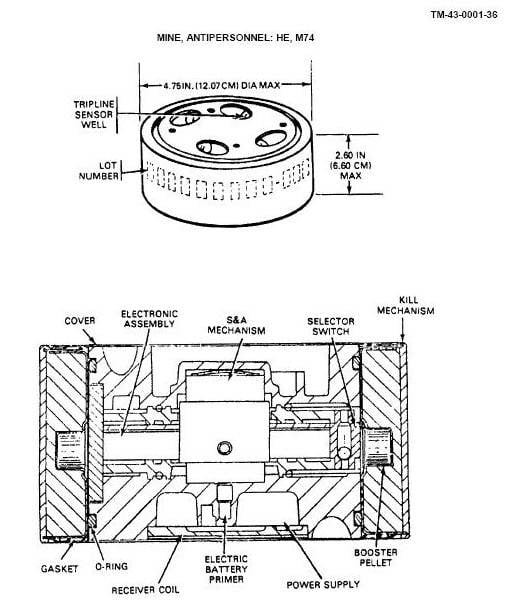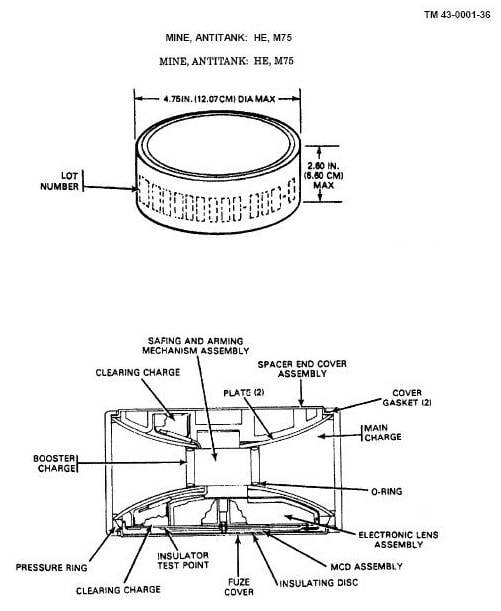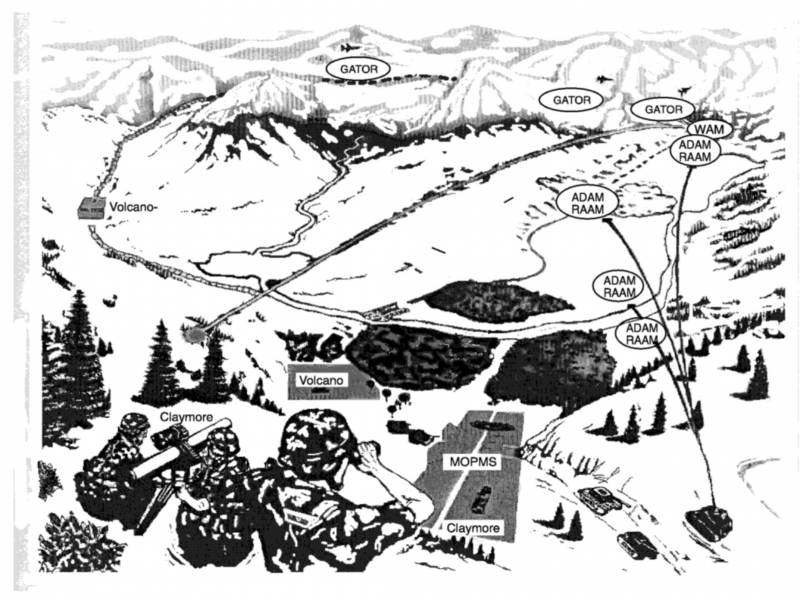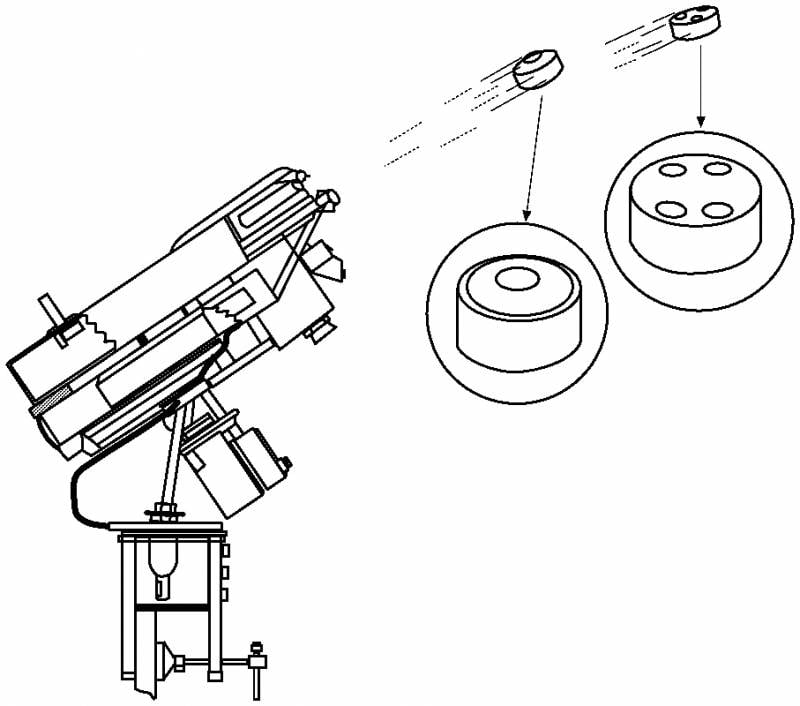M138 Flipper Remote Mining System (USA)
Compact installation
The next stage of development of mining systems for munitions of the FASCAM line (Family of Scatterable Mines - “Family of scattered mines”) started in the second half of the eighties. The existing M128 installation weighed several tons and needed a towing vehicle, although it could organize a minefield measuring 1000x60 m in one pass. The Pentagon considered it necessary to create a new mining system suitable for installation on any army equipment.
This sample later received the M138 index and the name Flipper. The project proposed the manufacture of a light launcher as a multi-barrel grenade launcher compatible with FASCAM mine launchers. Due to its small size, the installation was to be mounted on army vehicles. To solve this problem, it was necessary to sacrifice the dimensions of the ammunition ready for use, the speed of work, and other characteristics.
The M138 installation received a metal support with a clamp for mounting on a carrier machine and mounting a launcher. Clamp was proposed to put directly on board the body of the carrier vehicle. The dimensions and strength of the clamp were determined taking into account the recoil when firing. On the support there was an articulated base for a starting device and a firing control unit.
Actually, the Flipper launching device is a multi-barrel system with a caliber of about 130 mm. In the working position, cartridges with mines are placed in the trunks of the device. The design of the launcher provides horizontal aiming barrels within a sector width of 180 °. Shooting is carried out with a constant elevation angle, which gives the same range of min. Managing the tip is done manually: the rejection of any drives allowed to reduce weight.
Shooting is performed using the electrical system and the operator console. All electrical devices during installation of the M138 are connected to the vehicle electrical system. The remote has several modes of operation. It can give impulses for firing only at the command of the operator or perform firing in series with an interval of 10 seconds. With standard mining techniques, an interval shooting mode is used.

M74 anti-personnel mine
The M138 Flipper system, both in combat and in transport position, has minimal dimensions. Its height does not exceed 1 m, width - no more than 600-700 mm. Weight without ammunition - 110 pounds (50 kg). The fixed elevation angle allows you to send mines at a distance of 35 m. The rate of fire depends on the mode of operation.
Ammunition
The M138 remote mining system launches ammunition using special cartridges. Five types of mines are stacked in a metal cylindrical body. Between them, the type of so-called Roman candles placed low-power propelling charges. Ignition of charges is carried out by an electric pulse. The cassette assembly is a metal cup with a diameter of about 130 mm long less than 450 mm with a sealed lid. There are contacts for the firing control system on board the cassette.
The Flipper product was intended for the installation of M74 anti-personnel mines and M75 anti-tank mines from the FASCAM family. Both mines had similar cylindrical bodies with a diameter of about 125 mm and a height of approx. 60 mm. The mass of an anti-personnel mine is 1,41 kg, including 410 g of Composition B explosive. M74 used eight capron threads as target sensors. The mine ensured the destruction of targets in the radius of 4-6 m with the expansion of fragments to 25-30 m.
The M75 anti-tank weighed 1,7 kg and carried a cumulative 585-g charge with funnels at both ends, due to which the armored object is affected regardless of the position of the mine on the ground. Undermining was carried out with the help of a magnetic target sensor, which is triggered when a metal object approaches at 1 m. Penetration - a few centimeters.
Both FASCAM mines for M138 can remain in place for 5-15 days with a preset time setting. After its expiration or when the batteries are discharged, self-liquidator is triggered.
Work principles
Before going to mining, sappers had to prepare the M138 for work. Using a support with a clamp, the product is put on the rear side of almost any available car - HMMWV or truck. The choice of media depends on the state of the fleet of the engineering part. In the body of the carrier, next to the launcher, a stock of cartridges with mines of the necessary types is stored. In the immediate vicinity of the installation, its operators were supposed to work.

M75 anti-tank mine
Before mining, the marking of the future fence is carried out. On the minefield axis, 35 m segments are laid out and marks are made. Then the car with the Flipper should go to the first point; the calculation places the cassettes in the starting device and starts firing. To mine to the required depth, sappers must alternately shoot cartridges, before each shot, deploy the launcher at an angle of 15-20 degrees. Shooting begins with a maximum rotation of the trunks in one direction and ends with a maximum angle in the other direction. Shooting multiple cassettes from one point allows you to lay mines in an arc or a semicircle, the axis of symmetry of which is parallel to the front.
Further, the carrier vehicle passes another 35 m, recharging is carried out and the second portion of mines is shot. According to this technique, an ammunition “sows” a site of the required size.
The firing range of an M74 or M75 mine is 35 m. Thus, by turning the M138 launcher to its extreme positions, it is possible to organize a fencing depth of up to 70 m. As a result of several firing from different points, the mines lie in curved lines and cover the entire front. The length of such a mine-explosive fence depends on the consumption of cartridges / min and the duration of the sappers.
After setting the mines in a given area, the calculation should disconnect the launcher from the systems of the host vehicle and remove it from the board. The compact folding design allows the M138 to be transported with any available transport, including mining vehicles.
In service
M138 Flipper, a promising lightweight remote mining system, was adopted by the 1991. Soon, mass production began in the interests of the US Army. According to American charters, the light infantry division relies on three sets of Flipper. One product is used in two sapper platoons, another is attributed to the sapper company of the engineering battalion. The Airborne Division Engineering Battalion operates one M138 product.

Use of mining equipment in accordance with the statutes of FM 20-32, Mine / Contermine Operations. The M138 system can be used on any land site.
The M138 system was considered as an easy and convenient means for quick installation of minefields in hazardous areas. Placing the installation on a car or armored vehicle allows sappers to quickly enter the area of installation of mines and perform mining. The installation of ammunition can be carried out both in advance and on the way of the enemy. However, the work at the front edge is difficult due to the low mining speed and difficulties in providing crew protection.
The M138 Flipper was originally developed as an add-on for the heavier and less mobile trailed mining system M128 GEMMS. Subsequently, such an addition became a replacement. Due to poor performance, the GEMMS product was decommissioned in the mid-nineties. His tasks were distributed among other systems.
According to well-known data, the U.S. Army still continues to operate a certain number of M138 products. Together with them, other remote mining systems are in service, including intended for use by the mines of the FASCAM line. The presence of several different mining tools using standardized ammunition provides flexibility in the use of explosive barriers and allows the use of weaponmost relevant to current requirements.
Together with the M138 systems, FASCAM mines install guns with special artillery shells, MOMPS modular devices, self-propelled and aviation Vulcano installations, as well as Gator aviation cassettes. How long the Flipper system will remain in operation is unclear. It has limited characteristics, but gives the engineering departments the necessary capabilities and successfully solves its tasks, which allows it to continue its service.
- Ryabov Kirill
- Lexpev.nl, Nap.edu

Information